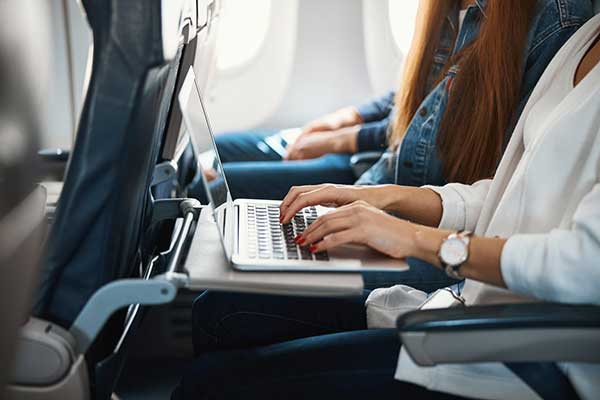In-flight WiFi sounds like a nice perk, but it comes with a fair amount of risk. Use these tips to keep yourself and your information safe.

Staying connected while in the air is a desire for many travelers, whether they want to touch base with colleagues, browse social media, or research something fun at their destination. While airlines have caught on to this traveler demand and many now offer WiFi, connecting while thousands of feet in the air isn’t the same as connecting in an office or coffee shop on the ground. Here’s a look at the potential benefits and risks of using in-flight WiFi, and ways to stay connected safely.
Airlines have two options if they want to offer WiFi:
With ATG, antennae connected to the plane receive the wireless signal from cellphone towers. The downside to this technology is that the strength of the signal depends on the availability of towers. If planes travel over large bodies of water or other areas with sparse coverage, users will see poor connectivity.
Satellite-based connections, on the other hand, rely on satellites to provide WiFi service. Satellites can more effectively cover a flight, but certain flight paths can still see drops in coverage.
Have a few hours in the air? With WiFi you can:
When joining the WiFi network on an airplane, whether using a phone, tablet, or laptop, be aware of the following:
If you’re using a phone or tablet to connect, here’s how you can help improve your productivity even in the face of not-ideal connectivity:
For some people, the risks might outweigh any desire to lose themselves in the world wide web. However, if you absolutely need to connect to airline WiFi, follow these steps to protect your information.
Use a VPN
Virtual Private Networks (VPNs) use technology to encrypt any data sent over the WiFi. This makes them a much more difficult target for hackers. You’ll need to select and purchase a VPN service before you fly.
While this service is a smart investment, don’t think of it as an impenetrable security wall. Even VPNs can get dropped temporarily during flights, leaving you vulnerable. If you don’t have a VPN, you might want to stick to reading the news or watching a movie – tasks that don’t require you to input a password or view anything confidential.
Use Antivirus Software
Before traveling, purchase antivirus software and download it on every device you want to use in-flight. This software will detect and block malware in real time, keeping you safe from many cyberthreats.
Connect to HTTPS Sites
Most websites today use HTTPS (seen at the beginning of a URL), but there are still HTTP sites out there. HTTPS is the better choice – whether in the air or on the ground – because it uses TLS or SSL encryption to make data requests and responses safer and more secure.
WiFi networks are never 100% secure because they are dynamic, always changing. This means they require constant oversight. However, with no IT experts onsite, and no automation tools or AI solutions watching the network, airplanes offer uniquely challenging WiFi environments for all users. Follow these tips to keep your information secure if you decide to use in-flight WiFi during any of your travels.

About the Author:
Roger Sands is the co-founder and CEO of Wyebot, Inc. He has 20+ years of executive management experience under his belt, gained from working with both successful networking startups and Fortune 500 companies, such as the following: Hewlett-Packard’s WW WLAN business, Colubris Networks, Accton Technology, 3com, USRobotics, and Bytex Corporation.
Scott Ellyson, CEO of East West Manufacturing, brings decades of global manufacturing and supply chain leadership to the conversation. In this episode, he shares practical insights on scaling operations, navigating complexity, and building resilient manufacturing networks in an increasingly connected world.